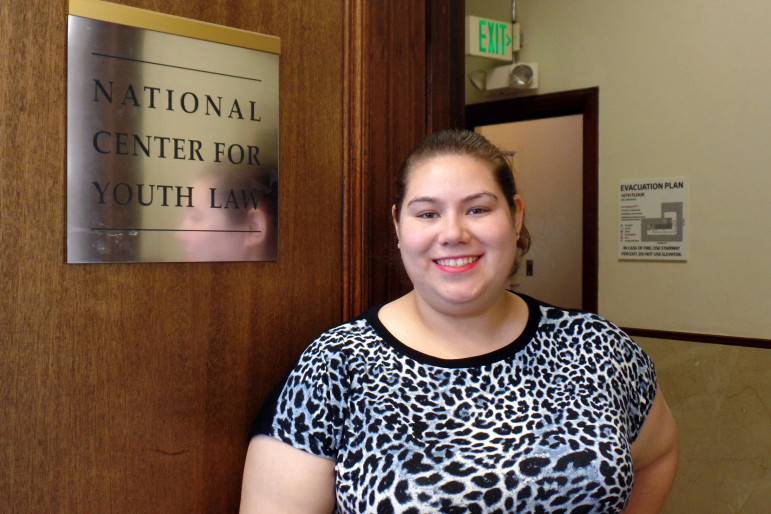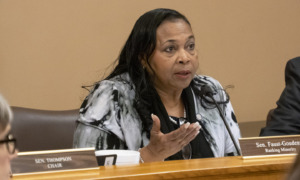
Elaine Korry
DeAngelo Cortijo, 22, told lawmakers he benefited more from therapeutic services than from psychiatric medications during his years in foster care.
This story also appeared on NPR’s health blog, Shots.
By the time DeAngelo Cortijo was 14, he had been in more than a dozen foster homes. He had run away and lived on the streets for months, and he had been diagnosed with bipolar and anxiety disorders, attachment disorder, intermittent explosive disorder or post-traumatic stress disorder. He had been in and out of mental hospitals and heavily medicated.
Cortijo, who was born in San Francisco, was taken from his mother after she attempted suicide when he was 3.
After his later diagnoses, he was prescribed a combination of antipsychotics, antidepressants and stimulants, and was told that taking them was his only hope of being normal. Instead, he said, medication made him feel “doped up and completely lost.”
It was not until he spent several months developing a relationship with a horse — “and it was huge,” said Cortijo with a smile — that he began to really acknowledge his own feelings. “Animals sense you, your fears, anxieties and insecurities,” he said.
Finding help through equine-assisted therapy — riding a horse, feeding, grooming and communicating with it — helped Cortijo to gain a better perspective on himself. “It allowed me to understand what a bond was, to realize I am an individual who is capable of caring, capable of being normal,” said Cortijo.
In recent years psychotropic drug use in foster care has been in the national spotlight. In 2011, the Government Accountability Office reported that children in foster care were prescribed antipsychotics at double to quadruple the rate of those not in foster care. In the states that were studied, hundreds of children were found to be taking five or more psychotropic medications at a time, although there is no medical evidence to support such a drug regimen. Thousands of children were prescribed doses that exceeded FDA-approved guidelines, and the report found monitoring programs for psychotropic drugs provided to foster children fell short of guidelines established by the American Academy of Child and Adolescent Psychiatry (AACAP).
Likewise, an Office of the Inspector General (OIG) report in March 2015 analyzed claims for psychotropic drugs that were paid for by Medicaid — the health insurer for most children in foster care. Medical reviewers identified quality-of-care concerns in more than two-thirds of the claims, including: too many drugs (37 percent), wrong dose (23 percent), poor monitoring (53 percent) or wrong treatment (41 percent). The OIG recommended that the Centers for Medicare & Medicaid Services (CMS) work with the states to enhance oversight, medical reviews and utilization reviews of psychotropics prescribed to children.
A sweeping package of laws to regulate the prescribing of powerful psychiatric medications to children and teens like Cortijo in the child-welfare system is heading to the governor’s desk in California — reforms that are already being eyed as possible federal legislation. Anna Johnson, a social analyst at the Oakland, Calif.-based National Center for Youth Law, which helped write the legislation, said a new enforcement mechanism was needed to change prescribing practices throughout youth services.
“The legislation describes in detail the oversight function — what everyone’s role is, from the juvenile court judge and the social workers, to the care providers, the lawyers, the doctors,” said Johnson. “And it names specifically the prescribing practices we want to see reduced: the use of multiple drugs on children, dosages that exceed maximums, and the use of antipsychotics where not medically necessary because of physical health risk factors.”
Leading reform in California
This comprehensive package of legislation follows last year’s publication of a series of investigative articles in the San Jose Mercury News, which alleged widespread over-reliance on antipsychotics and other psychiatric drugs without proper evaluation and monitoring, among the estimated 63,000 California children in foster care. Guidelines for the appropriate use of psychiatric drugs were either misunderstood or ignored, according to the series.
“It is well beyond time for us to be having this discussion and intervening,” said Ken Berrick, president and CEO of the Seneca Family of Agencies, which provides mental health, wraparound, child placement and family-focused services for children in California. According to Berrick, the over-reliance on medication has been a problem for decades, often because better alternatives simply weren’t available. “Medication is available right now on demand, and other services are not,” he said. “When you don’t have a choice, you rely on what you have.”
Monitoring, oversight and alternatives
Under the package of reforms, there would be better monitoring of children on medication and closer scrutiny of physicians who prescribe psychiatric drugs, to identify doctors who rely most heavily on medication. They could be targeted for education about the alternatives to medication. Senate Bill 484 also calls for stricter oversight of group homes to determine if psychotropic medications are used to control children’s behavior. “Drugging and sedating children should never be considered the primary option in lieu of counseling, therapy and appropriate treatment,” said the bill’s author Sen. Jim Beall, D-San Jose.
If the legislation is approved, social workers and caregivers in California would also receive training in the risks, benefits and side effects of psychiatric medications. A mix of state and federal dollars would establish a structure to provide second medical opinions.

Elaine Korry
Former foster youth Tisha Ortiz, 22, was prescribed antipsychotic medication for hallucinations she says she never experienced.
Beyond reining in prescribing outliers, the legislation also places a new emphasis on defining what comprises “appropriate care” for vulnerable youth. “It’s no longer a drugs-only approach,” explained Johnson, who said the new legislation would require children who are being given powerful medications also receive other services to help them with underlying symptoms.
“We’re saying, you have to do something else — either first or at the same time — to really help a troubled child,” said Johnson. “Swallowing a pill doesn’t help with grief or trauma. It may contain symptoms, but it doesn’t help you move forward and be functional in life.”
In June, the state Senate passed all four bills by a unanimous vote, sending what Beall called a clear message. “The system must never permit powerful psychotropic drugs to replace other effective and necessary treatments,” said Beall. The legislation is now being considered by the state Assembly, with no formal opposition.
Alternatives to meds may help more
In legislative hearings, former foster youth testified about negative side effects from taking psychotropic medications, sometimes unwillingly. And they described how alternatives to drug therapy often led to better outcomes.
“There is only one time I can say the system worked for me, and that is when juvenile probation in San Francisco sent me to a VisionQuest program in Arizona with equine-assisted therapy,” said Cortijo. “Just thinking about it now fills me with happiness and gratefulness,” he said.
For Tisha Ortiz, 22, help finally came in the form of a therapeutic behavioral services (TBS) worker who took a genuine interest in her. “I felt loved by her, that she actually cared,” said Ortiz.
[Sidebar: States Reform Use of Psychiatric Meds for Youth]
Ortiz had a chaotic childhood filled with emotional and sexual abuse. While she lived in various group homes, she often lashed out at adults and resorted to self-harm when her emotions got the better of her. For years Ortiz said she lived with flashbacks to early traumatic events, which her caregivers and social workers misinterpreted. “They considered the flashbacks as hearing voices, so I got put on psychotropic meds for that, when I wasn’t hearing voices at all.”
On medication Ortiz gained weight and found it hard to stay awake, yet she continued to feel abandoned and depressed. “I just felt sedated, and I wasn’t really dealing with the problems,” she said.
According to Ortiz, she did not begin to get better until she was connected with the TBS worker who encouraged her to talk about her past. “She helped me understand that what I was feeling was because of the situations I went through and not because there’s all these things wrong with me.”
Since then Ortiz has had other therapists who she felt really listened to her, whom she still occasionally calls if she’s had a bad day. But the self-harm has stopped, and she’s tapering off the one medication that she still takes. Ortiz says it was human interaction, and not drugs, that helped her. “Having that love was one of the first steps that put me on the road to getting better,” she said.
Evidence-based therapies
A broad array of evidence-based therapeutic services have been found to help youth with a history of extreme forms of neglect and abuse.
For example, California’s Quality Parenting Initiative is a collaboration between social services and child welfare to provide foster parents with the training to help children form trusting bonds and develop healthy coping mechanisms. In another approach known as wraparound services, multiple agencies surround a child with different supports ranging from psychosocial or educational to individual, group or family counseling.
“There are a lot of good evidence-based treatments that we know work,” said Shadi Houshyar, vice president for child welfare policy at First Focus, a national children’s advocacy organization. “States are just struggling with finding the providers, the resources and the dollars to pay for these interventions,” she said.
Some states resort to Medicaid waivers or use their child welfare general funds to match Medicaid dollars to draw down more federal spending, but according to Houshyar, it’s not enough. “We could use greater investment at the federal level,” she said. That’s why First Focus and other advocacy groups have been big proponents of a White House program aimed at curbing the misuse of psychiatric medication in foster care.
The Obama administration has called on all the states to advance alternative treatments in their child welfare systems. In his 2015 and 2016 budget proposals, President Obama unveiled a two-pronged plan allocating $750 million in the form of grant dollars and incentive payments to address the over-prescribing of psychotropics.
The demonstration project would bring child welfare and Medicaid agencies together to provide more coordinated services, including behavioral therapies, to foster kids with a history of trauma or mental health problems. “If we really want to solve this problem, we have to make the alternative interventions available at the same level at which medication is available,” said Berrick. “It’s really a question of access. When that happens, people will make the right decision,” he said.
A federal solution?
In the meantime, California is showing other states how to use multiple strategies to curb reliance on psychotropic medication. “It’s a really thoughtful approach that goes further than we’ve ever seen before,” said Houshyar.
One U.S. representative from the California delegation, Karen Bass, D-Los Angeles, has said she will present her state’s comprehensive package of reforms to the bipartisan Congressional Caucus on Foster Youth, which she created during her first term. Then it’s on to the U.S. House Ways and Means Committee. “I know that it will inspire other states,” said Bass. “I have no doubt about it.” Bass is considering sponsoring federal legislation modeled on California’s reforms.
It’s an approach that advocates such as DeAngelo Cortijo support. The former foster youth who was once told he needed medication to be “normal” has become a success without it. Now he shares his experience overcoming a tough childhood with other troubled youth as a juvenile justice intern at the National Center for Youth Law.
Don’t miss the sidebar “States Reform Use of Psychiatric Meds for Youth.”
Related to this article:
Recovery Communities: Where Addicts Get, Give Support for Long-term Recovery
Spirituality + Alcoholics Anonymous Prove Successful for LA Youth
Grant: Interventions for Youth Who Misuse/Abuse Prescription Medications






























